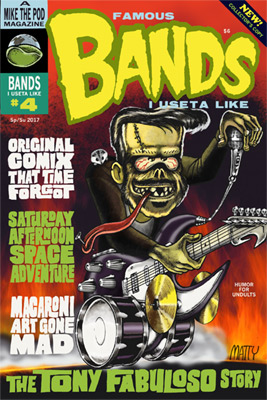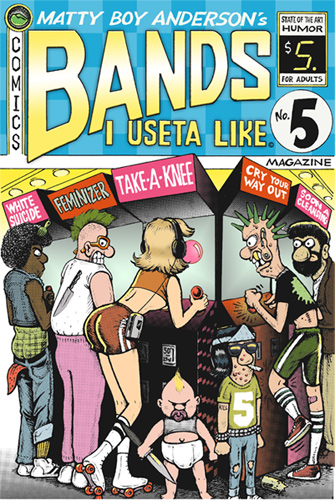In the 1960s, there were two unusual homesteads on television. One was monstrous, the other creepy and spooky. Both had excellent opening titles music.
The Munsters was easy to comprehend, for the most part; it was a show about a family of classic movie monsters (hence the pun). Father Herman was the great Fred Gwynne dolled up as a friendly Frankenstein’s monster; wife Lily and Grandpa were vampires. Son Eddie (Butch Patrick) was the wolf-boy, with a prominent widow’s-peak that ensured I would be humiliatingly likened to him, and daughter Marilyn was the freak, with no monstrous qualities whatsoever. They all lived in a spooky mansion on 1313 Mockingbird Lane. Who knew or cared about the genetics involved in such a lineage?
In the 60s, monsters often moonlighted as drag racers, and Herman was no exception. Whereas The Munsters was created as a send-up of monster movies, family sitcoms, and custom car culture, the show went on to make lasting contributions to all three.
This other family, though… they were extra weird.
Monsters, people can understand. A family of ghoulish creeps, who casually plot murder, and are suspicious of happiness? That’s a bit of a tougher sell.
On regular folks, anyway. I preferred the Addams family from day one. Like Indiana Jones and Daffy Duck, Gomez Addams is a personal idol of mine. I’ve tried to emulate his moustache (combined with Ernie Kovacs’) many times, with minimal success. He is the reason I learned how to fence. He’s the reason I have a fencing posture. That look that John Astin would get as Gomez; it happens naturally when you do something awesome with an épée.
Raul Julia was even more wonderful as Gomez, on the big screen, even though Carolyn Jones as Morticia was the most beautiful woman on TV, hands down. Whatever flaws they had, the two 1990s Addams Family movies got much of the flavor and atmosphere right. However, they used a similar fish-out-of-water formula to the successful Brady Bunch movies, treating the Addamses like misunderstood psychotics. It doesn’t work, because Hollywood insists upon explaining anything they think might distract the audience.
So, like The Garbage Pail Kids Movie, the script becomes about why these dark creatures are so dark, when the brevity of the gags is what allows it in the first place. This means taking one-panel cartoon jokes, extending them into scenes and dialogues, and pressing them into a cohesive narrative.
Think of it like taking a cutaway gag from Family Guy, and working backwards from there to build a full-length sitcom or motion picture. Those Addams Family flicks look a lot better now, don’t they?
You might not even know that the Addams family came from the work of one of the greatest cartoonists of all time. Heck, why do you think their last name is “Addams”?
Charles Samuel “Chas” Addams (1912–1988) was an American cartoonist known for his darkly humorous and macabre characters. [Wikipedia] He programmed the family genome. You can see the residue of his original ‘toons in the background of the shows and movies, like the traffic signs that adorn Pugsley’s bedroom wall. One of the films even opens with an adaptation of a classic 1946 Addams New Yorker cartoon:

The joke is that the Christmas carolers will be seared to death by boiling oil. Depicting the outcome would belabor it, and mess up the funny.
Charles Addams was the master of gallows humor; in fact his cartoons often featured gallows. He was just a touch warmer than Edward Gorey, and he looked kind of like Walter Matthau. Gomez and the rest of the “Addams Family” first appeared in Charles’ New Yorker cartoons, in the 1930s and 40s. Everyone is recognizable on sight, especially Uncle Fester, who roused belly-laughs without even a caption.
From 1932 until his death in 1988, Addams contributed over 1300 cartoons to the New Yorker and other periodicals. 1300! Plus cover paintings!
His eponymous family gets the most attention, but Charles was a true god of his medium, capable of breathing life into a diverse palette of parables and twisted fables. All in the space of a single image!

Well looky there, it’s the greatest cartoon you’ve ever seen in your life! (Charles Addams, New Yorker, 3/10/1956)
A house on Elm Street, and another on Dudley Avenue into which police once caught him breaking and entering, are said to be the inspiration for the Addams Family mansion in his cartoons. College Hall, the oldest building on the current campus of the University of Pennsylvania, where Addams studied, was also an inspiration for the mansion. He was fond of visiting the Presbyterian Cemetery on Mountain Avenue. One friend said of him: “His sense of humor was a little different from everybody else’s.” He was also artistically inclined, “drawing with a happy vengeance”, according to a biographer. [Wikipedia]
Don’t ask how I know this, but if you break into a building while young, it influences stuff you draw later on. You pay really close attention to the physical parameters of that building. I’d argue that it’s an unorthodox form of study, but I got as much knowledge painting houses as I ever did breaking into them, if not more so.
Addams did New Yorker ‘toons for all occasions (funerals in particular), but as for holidays, he fit Halloween like a black glove. His stuff was creepy in general, but come autumn, Chas cranked the spooky up to 11.
For Charles Addams and his family, every day was Halloween. His art always had a playful creepiness, the kind only harmful to clumsy boys and girls. Things that go ‘bump’ in the night. Dangers lurking under beds, and behind closet doors.
Just as The Munsters had its roots in the classic literary creations of Shelley and Stoker, The Addams Family had its own icons. Astoundingly, they came from the mind of one New Jersey cartoonist.
(Addams’ cartoons on this page came from The World of Charles Addams, published in 1991 by Alfred A. Knopf.)
















You must be logged in to post a comment.